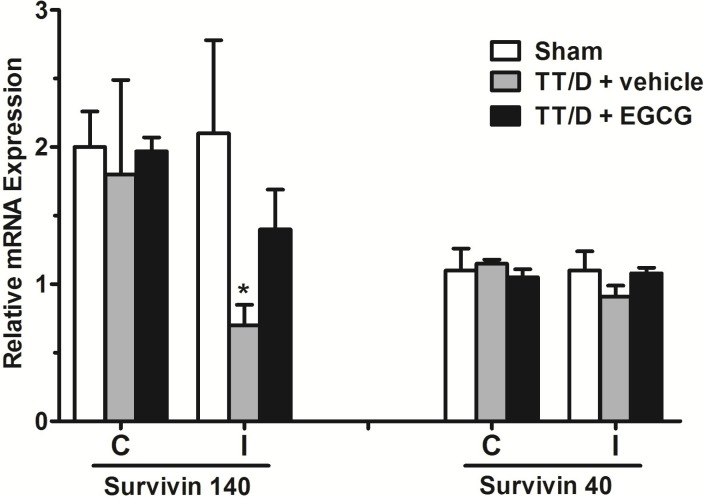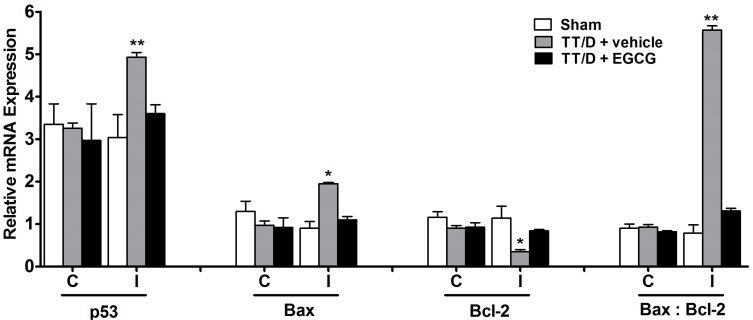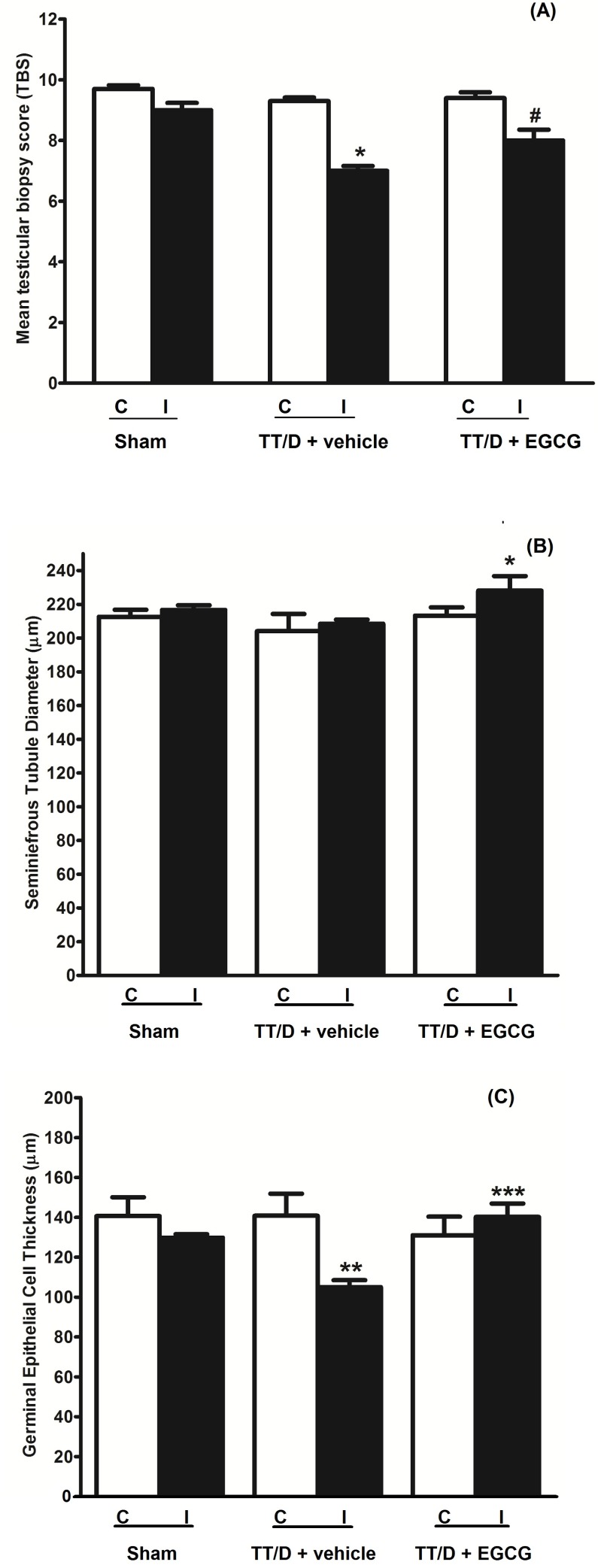Korean J Physiol Pharmacol.
2013 Aug;17(4):259-265. 10.4196/kjpp.2013.17.4.259.
(-)-Epigallocatechin-3-gallate Modulates the Differential Expression of Survivin Splice Variants and Protects Spermatogenesis During Testicular Torsion
- Affiliations
-
- 1Department of Natural Sciences, College of Health Sciences, The Public Authority for Applied Education & Training, Safat 13092, Kuwait.
- 2Department of Biochemistry, Faculty of Medicine-Kuwait University, Safat 24923, Kuwait. malmaghrebi@hsc.edu.kw
- 3Department of Anatomy, Faculty of Medicine-Kuwait University, Safat 24923, Kuwait.
- KMID: 2285459
- DOI: http://doi.org/10.4196/kjpp.2013.17.4.259
Abstract
- The anti-apoptotic effect of (-)-epigallocatechin-3-gallate (EGCG) during unilateral testicular torsion and detorsion (TT/D) was established in our previous study. In mice, the smallest inhibitor of apoptosis, survivin, is alternatively spliced into three variants, each suggested to have a unique function. Here, we assessed how EGCG exerts its protective effect through the expression of the different survivin splice variants and determined its effect on the morphology of the seminiferous tubules during TT/D. Three mouse groups were used: sham, TT/D+vehicle and TT/D treated with EGCG. The expression of the survivin variants (140 and 40) and other apoptosis genes (p53, Bax and Bcl-2) was measured with semi-quantitative RT-PCR. Histological analysis was performed to assess DNA fragmentation, damage to spermatogenesis and morphometric changes in the seminiferous tubules. In the TT/D+vehicle group, survivin 140 expression was markedly decreased, whereas survivin 40 expression was not significantly different. In parallel, there was an increase in the mRNA level of p53 and the Bax to Bcl-2 ratio in support of apoptosis induction. Histological analyses revealed increased DNA fragmentation and increased damage to spermatogenesis associated with decreased seminiferous tubular diameter and decreased germinal epithelial cell thickness in the TT/D+vehicle group. These changes were reversed to almost sham levels upon EGCG treatment. Our data indicate that EGCG protects the testis from TT/D-induced damage by protecting the morphology of the seminiferous tubules and modulating survivin 140 expression.
Keyword
MeSH Terms
Figure
Cited by 1 articles
-
Reversal of Cisplatin Resistance by Epigallocatechin Gallate Is Mediated by Downregulation of Axl and Tyro 3 Expression in Human Lung Cancer Cells
Kyung-Chan Kim, ChuHee Lee
Korean J Physiol Pharmacol. 2014;18(1):61-66. doi: 10.4196/kjpp.2014.18.1.61.
Reference
-
1. Singh BN, Shankar S, Srivastava RK. Green tea catechin, epigallocatechin-3-gallate (EGCG): mechanisms, perspectives and clinical applications. Biochem Pharmacol. 2011; 82:1807–1821. PMID: 21827739.
Article2. Borska S, Gebarowska E, Wysocka T, Drag-Zalesińska M, Zabel M. Induction of apoptosis by EGCG in selected tumour cell lines in vitro. Folia Histochem Cytobiol. 2003; 41:229–232. PMID: 14677763.3. Lambert JD, Yang CS. Mechanisms of cancer prevention by tea constituents. J Nutr. 2003; 133:3262S–3267S. PMID: 14519824.
Article4. Gupta S, Hastak K, Afaq F, Ahmad N, Mukhtar H. Essential role of caspases in epigallocatechin-3-gallate-mediated inhibition of nuclear factor kappa B and induction of apoptosis. Oncogene. 2004; 23:2507–2522. PMID: 14676829.5. Chen ZP, Schell JB, Ho CT, Chen KY. Green tea epigallocatechin gallate shows a pronounced growth inhibitory effect on cancerous cells but not on their normal counterparts. Cancer Lett. 1998; 129:173–179. PMID: 9719459.
Article6. Al-Maghrebi M, Renno WM, Al-Ajmi N. Epigallocatechin-3-gallate inhibits apoptosis and protects testicular seminiferous tubules from ischemia/reperfusion-induced inflammation. Biochem Biophys Res Commun. 2012; 420:434–439. PMID: 22426481.
Article7. Horica CA, Hadziselimovic F, Kreutz G, Bandhauer K. Ultrastructural studies of the contorted and contralateral testicle in unilateral testicular torsion. Eur Urol. 1982; 8:358–362. PMID: 7140786.8. Thomas WE, Williamson RC. Diagnosis and outcome of testicular torsion. Br J Surg. 1983; 70:213–216. PMID: 6831173.
Article9. Cheung CH, Cheng L, Chang KY, Chen HH, Chang JY. Investigations of survivin: the past, present and future. Front Biosci (Landmark Ed). 2011; 16:952–961. PMID: 21196211.
Article10. Mahotka C, Wenzel M, Springer E, Gabbert HE, Gerharz CD. Survivin-deltaEx3 and survivin-2B: two novel splice variants of the apoptosis inhibitor survivin with different antiapoptotic properties. Cancer Res. 1999; 59:6097–6102. PMID: 10626797.11. Johnson AL, Langer JS, Bridgham JT. Survivin as a cell cycle-related and antiapoptotic protein in granulosa cells. Endocrinology. 2002; 143:3405–3413. PMID: 12193553.
Article12. Conway EM, Pollefeyt S, Cornelissen J, DeBaere I, Steiner-Mosonyi M, Ong K, Baens M, Collen D, Schuh AC. Three differentially expressed survivin cDNA variants encode proteins with distinct antiapoptotic functions. Blood. 2000; 95:1435–1442. PMID: 10666222.
Article13. Absalan F, Movahedin M, Mowla SJ. Germ cell apoptosis induced by experimental cryptorchidism is mediated by molecular pathways in mouse testis. Andrologia. 2010; 42:5–12. PMID: 20078510.
Article14. Amiri S, Movahedin M, Mowla SJ, Hajebrahimi Z, Tavallaei M. Differential gene expression and alternative splicing of survivin following mouse sciatic nerve injury. Spinal Cord. 2009; 47:739–744. PMID: 19333244.
Article15. Absalan F, Movahedin M, Mowla SJ. Evaluation of apoptotic genes expression and its protein after treatment of cryptorchid mice. Iran Biomed J. 2012; 16:77–83. PMID: 22801280.16. Aktaş BK, Bulut S, Bulut S, Baykam MM, Ozden C, Senes M, Yücel D, Memiş A. The effects of N-acetylcysteine on testicular damage in experimental testicular ischemia/reperfusion injury. Pediatr Surg Int. 2010; 26:293–298. PMID: 19911182.
Article17. Mehraein F, Negahdar F. Morphometric evaluation of seminiferous tubules in aged mice testes after melatonin administration. Cell J. 2011; 13:1–4. PMID: 23671820.18. Osinubi AA, Noronha CC, Okanlawon AO. Morphometric and stereological assessment of the effects of long-term administration of quinine on the morphology of rat testis. West Afr J Med. 2005; 24:200–205. PMID: 16276694.
Article19. Johnsen SG. Testicular biopsy score count--a method for registration of spermatogenesis in human testes: normal values and results in 335 hypogonadal males. Hormones. 1970; 1:2–25. PMID: 5527187.20. Uren AG, Wong L, Pakusch M, Fowler KJ, Burrows FJ, Vaux DL, Choo KH. Survivin and the inner centromere protein INCENP show similar cell-cycle localization and gene knockout phenotype. Curr Biol. 2000; 10:1319–1328. PMID: 11084331.
Article21. Ambrosini G, Adida C, Altieri DC. A novel anti-apoptosis gene, survivin, expressed in cancer and lymphoma. Nat Med. 1997; 3:917–921. PMID: 9256286.
Article22. Fukuda S, Pelus LM. Regulation of the inhibitor-of-apoptosis family member survivin in normal cord blood and bone marrow CD34(+) cells by hematopoietic growth factors: implication of survivin expression in normal hematopoiesis. Blood. 2001; 98:2091–2100. PMID: 11567995.
Article23. Kobayashi K, Hatano M, Otaki M, Ogasawara T, Tokuhisa T. Expression of a murine homologue of the inhibitor of apoptosis protein is related to cell proliferation. Proc Natl Acad Sci U S A. 1999; 96:1457–1462. PMID: 9990045.
Article24. Noton EA, Colnaghi R, Tate S, Starck C, Carvalho A, Ko Ferrigno P, Wheatley SP. Molecular analysis of survivin isoforms: evidence that alternatively spliced variants do not play a role in mitosis. J Biol Chem. 2006; 281:1286–1295. PMID: 16291752.25. Vagnarelli P, Earnshaw WC. Chromosomal passengers: the four-dimensional regulation of mitotic events. Chromosoma. 2004; 113:211–222. PMID: 15351889.
Article26. Yang D, Welm A, Bishop JM. Cell division and cell survival in the absence of survivin. Proc Natl Acad Sci U S A. 2004; 101:15100–15105. PMID: 15477601.
Article27. Zheng WY, Kang YY, Li LF, Xu YX, Ma XY. Levels of effectiveness of gene therapies targeting survivin and its splice variants in human breast cancer cells. Drug Discov Ther. 2011; 5:293–298. PMID: 22466440.
Article28. Marioni G, Agostini M, Bedin C, Blandamura S, Stellini E, Favero G, Lionello M, Giacomelli L, Burti S, D'Angelo E, Nitti D, Staffieri A, De Filippis C. Survivin and laryngeal carcinoma prognosis: nuclear localization and expression of splice variants. Histopathology. 2012; 61:247–256. PMID: 22416874.
Article29. Pentikäinen V, Dunkel L, Erkkilä K. Male germ cell apoptosis. Endocr Dev. 2003; 5:56–80. PMID: 12629892.30. Rudner AD, Murray AW. The spindle assembly checkpoint. Curr Opin Cell Biol. 1996; 8:773–780. PMID: 8939672.
Article31. Hengartner MO. The biochemistry of apoptosis. Nature. 2000; 407:770–776. PMID: 11048727.
Article32. O'Connor DS, Wall NR, Porter AC, Altieri DC. A p34(cdc2) survival checkpoint in cancer. Cancer Cell. 2002; 2:43–54. PMID: 12150824.33. Wang Y, Suominen JS, Hakovirta H, Parvinen M, Martinand-Mari C, Toppari J, Robbins I. Survivin expression in rat testis is upregulated by stem-cell factor. Mol Cell Endocrinol. 2004; 218:165–174. PMID: 15130521.
Article34. Allan DJ, Harmon BV, Kerr JFR. Cell death in spermatogenesis: perspectives on mammalian cell death. Oxford: University Press;c1987. p. 229.35. Clermont Y. Quantitative analysis of spermatogenesis of the rat: a revised model for the renewal of spermatogonia. Am J Anat. 1962; 111:111–129. PMID: 13879927.
Article36. Roosen-Runge EC. Germinal-cell loss in normal metazoan spermatogenesis. J Reprod Fertil. 1973; 35:339–348. PMID: 4584655.
Article37. Britschgi A, Simon HU, Tobler A, Fey MF, Tschan MP. Epigallocatechin-3-gallate induces cell death in acute myeloid leukaemia cells and supports all-trans retinoic acid-induced neutrophil differentiation via death-associated protein kinase 2. Br J Haematol. 2010; 149:55–64. PMID: 20096012.38. Johnson JJ, Bailey HH, Mukhtar H. Green tea polyphenols for prostate cancer chemoprevention: a translational perspective. Phytomedicine. 2010; 17:3–13. PMID: 19959000.
Article39. Farabegoli F, Papi A, Bartolini G, Ostan R, Orlandi M. (-)-Epigallocatechin-3-gallate downregulates Pg-P and BCRP in a tamoxifen resistant MCF-7 cell line. Phytomedicine. 2010; 17:356–362. PMID: 20149610.
Article40. Tang SN, Singh C, Nall D, Meeker D, Shankar S, Srivastava RK. The dietary bioflavonoid quercetin synergizes with epigallocathechin gallate (EGCG) to inhibit prostate cancer stem cell characteristics, invasion, migration and epithelial-mesenchymal transition. J Mol Signal. 2010; 5:14. PMID: 20718984.
Article41. McLaughlin N, Annabi B, Bouzeghrane M, Temme A, Bahary JP, Moumdjian R, Béliveau R. The Survivin-mediated radioresistant phenotype of glioblastomas is regulated by RhoA and inhibited by the green tea polyphenol (-)-epigallocatechin-3-gallate. Brain Res. 2006; 1071:1–9. PMID: 16412397.
Article42. Onoda C, Kuribayashi K, Nirasawa S, Tsuji N, Tanaka M, Kobayashi D, Watanabe N. (-)-Epigallocatechin-3-gallate induces apoptosis in gastric cancer cell lines by down-regulating survivin expression. Int J Oncol. 2011; 38:1403–1408. PMID: 21344159.
Article43. Altavilla D, Romeo C, Squadrito F, Marini H, Morgia G, Antonuccio P, Minutoli L. Molecular pathways involved in the early and late damage induced by testis ischemia: evidence for a rational pharmacological modulation. Curr Med Chem. 2012; 19:1219–1224. PMID: 22300051.44. Oeckinghaus A, Hayden MS, Ghosh S. Crosstalk in NF-κB signaling pathways. Nat Immunol. 2011; 12:695–708. PMID: 21772278.
Article45. Chu SH, Lim JW, Kim DG, Lee ES, Kim KH, Kim H. Down-regulation of Bcl-2 is mediated by NF-κB activation in Helicobacter pylori-induced apoptosis of gastric epithelial cells. Scand J Gastroenterol. 2011; 46:148–155. PMID: 20969490.46. Jeyasuria P, Subedi K, Suresh A, Condon JC. Elevated levels of uterine anti-apoptotic signaling may activate NFKB and potentially confer resistance to caspase 3-mediated apoptotic cell death during pregnancy in mice. Biol Reprod. 2011; 85:417–424. PMID: 21566000.47. Eckelman BP, Salvesen GS, Scott FL. Human inhibitor of apoptosis proteins: why XIAP is the black sheep of the family. EMBO Rep. 2006; 7:988–994. PMID: 17016456.
Article48. Mehrotra S, Languino LR, Raskett CM, Mercurio AM, Dohi T, Altieri DC. IAP regulation of metastasis. Cancer Cell. 2010; 17:53–64. PMID: 20129247.
Article49. Kim SJ, Lee JH, Kim BS, So HS, Park R, Myung NY, Um JY, Hong SH. (-)-Epigallocatechin-3-gallate protects against NO-induced ototoxicity through the regulation of caspase-1, caspase-3, and NF-κB activation. PLoS One. 2012; 7:e43967. PMID: 23028481.50. Ortega-Ferrusola C, García BM, Gallardo-Bolaños JM, González-Fernández L, Rodríguez-Martinez H, Tapia JA, Peña FJ. Apoptotic markers can be used to forecast the freezeability of stallion spermatozoa. Anim Reprod Sci. 2009; 114:393–403. PMID: 19019584.
Article
- Full Text Links
- Actions
-
Cited
- CITED
-
- Close
- Share
- Similar articles
-
- Expression of the survivin-2B splice variant related to the progression of colorectal carcinoma
- The Effect of Testicular Torsion on the Histologic Findings and Apoptosis of the Contralateral Testis at Various Ages in Rats
- The Role of Clusterin in Apoptosis Induced by Testicular Torsion
- Neonatal Testicular Torsion Mimicking a Testicular Tumor
- A Case of Antenatal Testicular Torsion Mimicking Inflammation and Tumor in the Neonate





